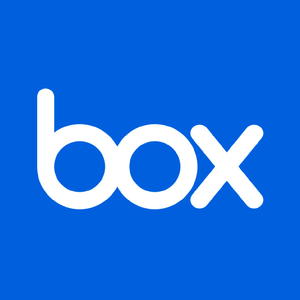
Asana (ASAN)
Asana keeps us up at night. Its growth has decelerated and its failure to generate meaningful free cash flow makes us question its prospects.― StockStory Analyst Team
1. News
2. Summary
Why We Think Asana Will Underperform
Born from the founders' frustration with the inefficiencies of email-based collaboration at Facebook, Asana (NYSE:ASAN) provides a work management platform that helps organizations track projects, set goals, and manage workflows in a centralized digital workspace.
- Historical operating margin losses point to an inefficient cost structure
- Competitive market means the company must spend more on sales and marketing to stand out even if the return on investment is low
- Platform has low switching costs as its net revenue retention rate of 95.7% demonstrates high turnover


Asana is in the doghouse. We’ve identified better opportunities elsewhere.
Why There Are Better Opportunities Than Asana
High Quality
Investable
Underperform
Why There Are Better Opportunities Than Asana
Asana is trading at $14.12 per share, or 4.1x forward price-to-sales. This is a cheap valuation multiple, but for good reason. You get what you pay for.
It’s better to pay up for high-quality businesses with higher long-term earnings potential rather than to buy lower-quality stocks because they appear cheap. These challenged businesses often don’t re-rate, a phenomenon known as a “value trap”.
3. Asana (ASAN) Research Report: Q3 CY2025 Update
Work management platform Asana (NYSE:ASAN) reported Q3 CY2025 results exceeding the market’s revenue expectations, with sales up 9.3% year on year to $201 million. Guidance for next quarter’s revenue was better than expected at $205 million at the midpoint, 0.8% above analysts’ estimates. Its non-GAAP profit of $0.07 per share was in line with analysts’ consensus estimates.
Asana (ASAN) Q3 CY2025 Highlights:
- Revenue: $201 million vs analyst estimates of $198.8 million (9.3% year-on-year growth, 1.1% beat)
- Adjusted EPS: $0.07 vs analyst estimates of $0.06 (in line)
- Adjusted Operating Income: $16.34 million vs analyst estimates of $13.28 million (8.1% margin, 23.1% beat)
- Revenue Guidance for Q4 CY2025 is $205 million at the midpoint, above analyst estimates of $203.3 million
- Management raised its full-year Adjusted EPS guidance to $0.26 at the midpoint, a 6.3% increase
- Operating Margin: -34.8%, down from -32.7% in the same quarter last year
- Free Cash Flow Margin: 6.7%, down from 18% in the previous quarter
- Customers: 25,413 customers paying more than $5,000 annually
- Net Revenue Retention Rate: 96%, in line with the previous quarter
- Billings: $192.5 million at quarter end, up 8.9% year on year
- Market Capitalization: $3.02 billion
Company Overview
Born from the founders' frustration with the inefficiencies of email-based collaboration at Facebook, Asana (NYSE:ASAN) provides a work management platform that helps organizations track projects, set goals, and manage workflows in a centralized digital workspace.
The company's platform is built around its proprietary Asana Work Graph data model, which captures the relationships between work units (tasks, projects, goals), the people doing the work, and all associated information. This structure creates a single source of truth for organizational work, eliminating the need for status meetings and reducing time spent on coordination.
Asana's platform offers multiple interactive views—including lists, boards, timelines, and calendars—allowing different teams to visualize the same underlying data in whatever format works best for them. Users can create automated workflows with a point-and-click builder, set rules to eliminate repetitive tasks, and standardize processes with customizable forms and templates.
For executives, Asana provides visibility into company-wide goals and real-time progress tracking. Team leads gain insights into resource allocation and potential bottlenecks, while individuals benefit from clear task ownership and priorities. A typical enterprise customer might use Asana to manage complex cross-functional initiatives like product launches or employee onboarding, with leadership tracking progress against strategic objectives.
Asana generates revenue through subscription plans, with pricing tiers based on features and functionality. The company has enhanced its platform with AI capabilities called Asana Intelligence, which leverages the Work Graph to provide contextual insights, generate status updates, and answer questions about projects. Asana's platform integrates with over 300 third-party applications, including Microsoft 365, Google Workspace, Salesforce, and Slack, allowing teams to connect their existing tools into their workflows.
4. Project Management Software
The future of work requires teams to collaborate across departments and remote offices. Project management software is both driving this change and benefiting from it. While the trend of collaborative work management has been strong for a while, the Covid pandemic has definitively accelerated the demand for tools that allow work to be done remotely.
Asana competes with project management and collaboration tools like Monday.com (NASDAQ:MNDY), Smartsheet (NYSE:SMAR), Atlassian's Trello and Jira (NASDAQ:TEAM), and Microsoft's Planner (NASDAQ:MSFT). The company also faces competition from broader collaboration platforms like Notion, Airtable, and ClickUp.
5. Revenue Growth
A company’s long-term performance is an indicator of its overall quality. Any business can have short-term success, but a top-tier one grows for years. Thankfully, Asana’s 30.8% annualized revenue growth over the last five years was impressive. Its growth beat the average software company and shows its offerings resonate with customers.

We at StockStory place the most emphasis on long-term growth, but within software, a half-decade historical view may miss recent innovations or disruptive industry trends. Asana’s recent performance shows its demand has slowed significantly as its annualized revenue growth of 10.7% over the last two years was well below its five-year trend. 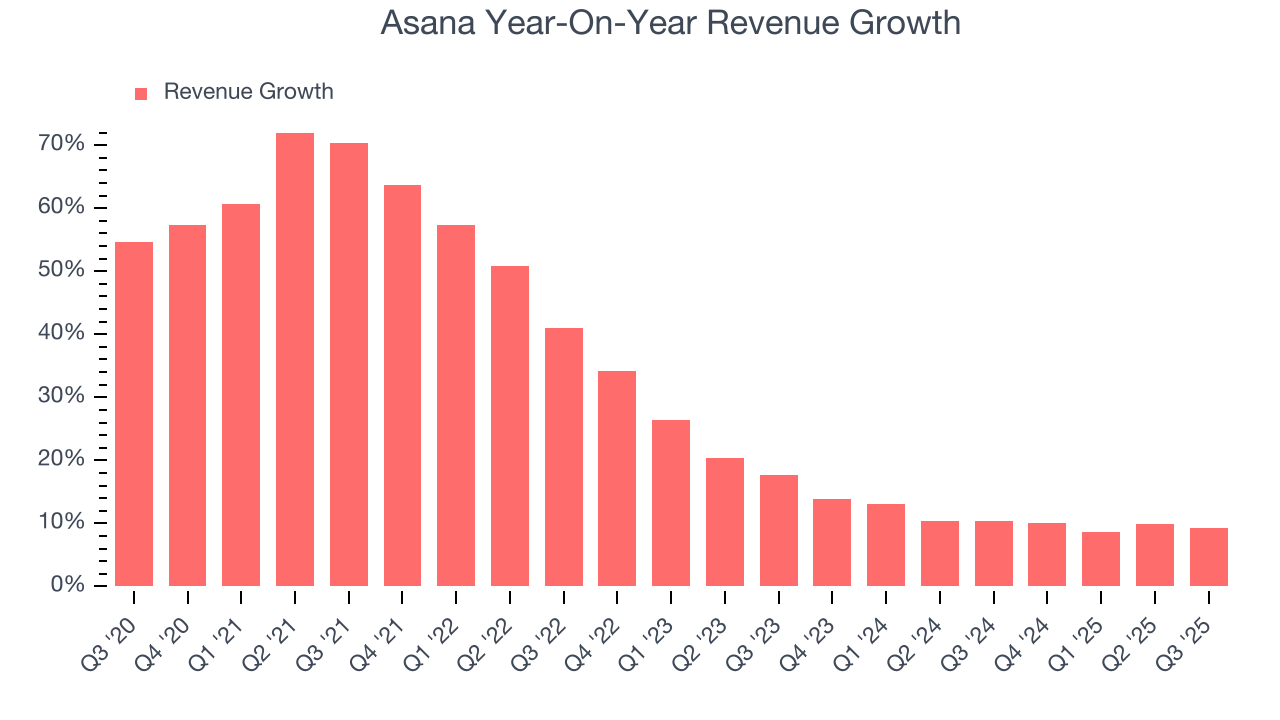
This quarter, Asana reported year-on-year revenue growth of 9.3%, and its $201 million of revenue exceeded Wall Street’s estimates by 1.1%. Company management is currently guiding for a 8.8% year-on-year increase in sales next quarter.
Looking further ahead, sell-side analysts expect revenue to grow 7.9% over the next 12 months, a slight deceleration versus the last two years. This projection doesn't excite us and suggests its products and services will see some demand headwinds.
6. Billings
Billings is a non-GAAP metric that is often called “cash revenue” because it shows how much money the company has collected from customers in a certain period. This is different from revenue, which must be recognized in pieces over the length of a contract.
Asana’s billings came in at $192.5 million in Q3, and over the last four quarters, its growth was underwhelming as it averaged 9.3% year-on-year increases. This performance mirrored its total sales and suggests that increasing competition is causing challenges in acquiring/retaining customers. 
7. Enterprise Customer Base
This quarter, Asana reported 25,413 enterprise customers paying more than $5,000 annually, an increase of 407 from the previous quarter. That’s a bit fewer contract wins than last quarter and quite a bit below what we’ve observed over the previous year, suggesting its sales momentum with new enterprise customers is slowing. It also implies that Asana will likely need to upsell its existing large customers or move down market to accelerate its top-line growth.

8. Customer Acquisition Efficiency
The customer acquisition cost (CAC) payback period measures the months a company needs to recoup the money spent on acquiring a new customer. This metric helps assess how quickly a business can break even on its sales and marketing investments.
Asana’s recent customer acquisition efforts haven’t yielded returns as its CAC payback period was negative this quarter, meaning its incremental sales and marketing investments outpaced its revenue. This inefficiency partly stems from its focus on enterprise clients who require some degree of customization, resulting in long onboarding periods that delay customer spending.
9. Customer Retention
One of the best parts about the software-as-a-service business model (and a reason why they trade at high valuation multiples) is that customers typically spend more on a company’s products and services over time.
Asana’s net revenue retention rate, a key performance metric measuring how much money existing customers from a year ago are spending today, was 95.7% in Q3. This means Asana’s revenue would’ve decreased by 4.3% over the last 12 months if it didn’t win any new customers.

Asana has a weak net retention rate, signaling that some customers aren’t satisfied with its products, leading to lost contracts and revenue streams.
10. Gross Margin & Pricing Power
For software companies like Asana, gross profit tells us how much money remains after paying for the base cost of products and services (typically servers, licenses, and certain personnel). These costs are usually low as a percentage of revenue, explaining why software is more lucrative than other sectors.
Asana’s gross margin is one of the highest in the software sector, an output of its asset-lite business model and strong pricing power. It also enables the company to fund large investments in new products and sales during periods of rapid growth to achieve outsized profits at scale. As you can see below, it averaged an elite 89.5% gross margin over the last year. That means Asana only paid its providers $10.52 for every $100 in revenue.
The market not only cares about gross margin levels but also how they change over time because expansion creates firepower for profitability and free cash generation. Asana has seen gross margins decline by 0.7 percentage points over the last 2 year, which is slightly worse than average for software.

This quarter, Asana’s gross profit margin was 88.9%, in line with the same quarter last year. Zooming out, the company’s full-year margin has remained steady over the past 12 months, suggesting its input costs have been stable and it isn’t under pressure to lower prices.
11. Operating Margin
Asana’s expensive cost structure has contributed to an average operating margin of negative 29.3% over the last year. Unprofitable, high-growth software companies require extra attention because they spend heaps of money to capture market share. As seen in its fast historical revenue growth, this strategy seems to have worked so far, but it’s unclear what would happen if Asana reeled back its investments. Wall Street seems to think it will face some obstacles, and we tend to agree.
Over the last two years, Asana’s expanding sales gave it operating leverage as its margin rose by 9 percentage points. Still, it will take much more for the company to reach long-term profitability.
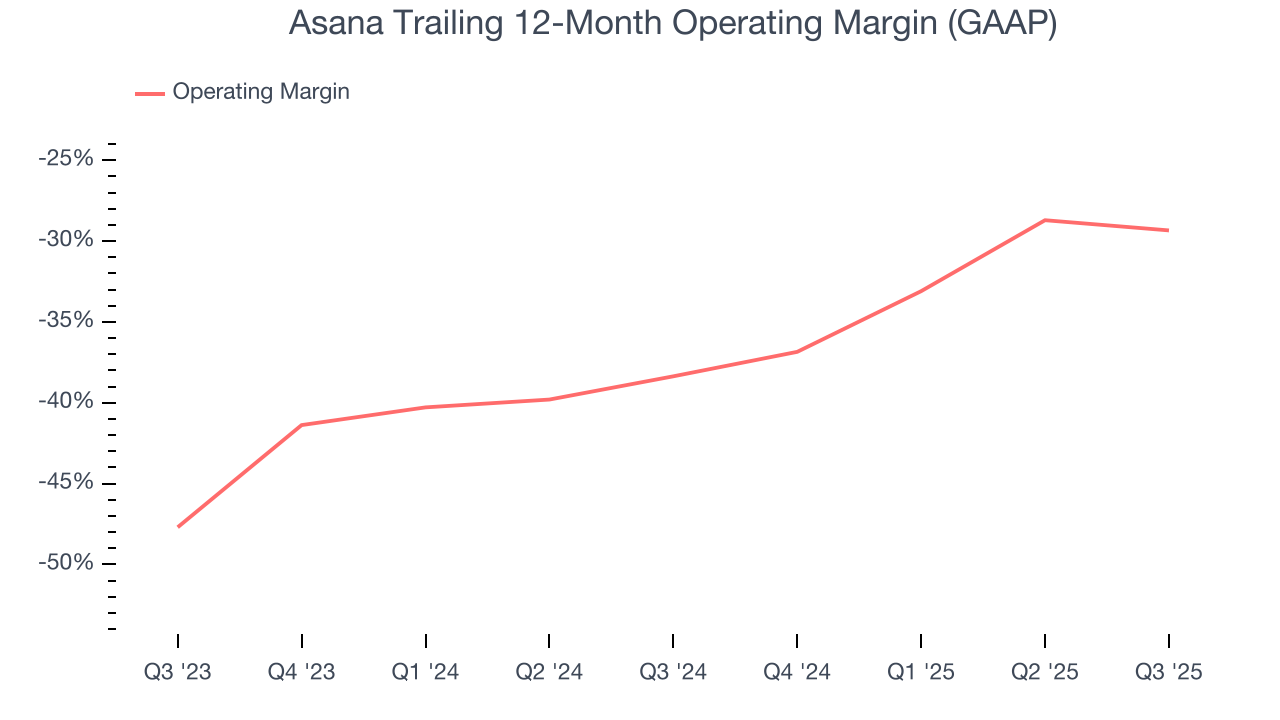
This quarter, Asana generated a negative 34.8% operating margin.
12. Cash Is King
Although earnings are undoubtedly valuable for assessing company performance, we believe cash is king because you can’t use accounting profits to pay the bills.
Asana has shown weak cash profitability over the last year, giving the company limited opportunities to return capital to shareholders. Its free cash flow margin averaged 9.2%, subpar for a software business.
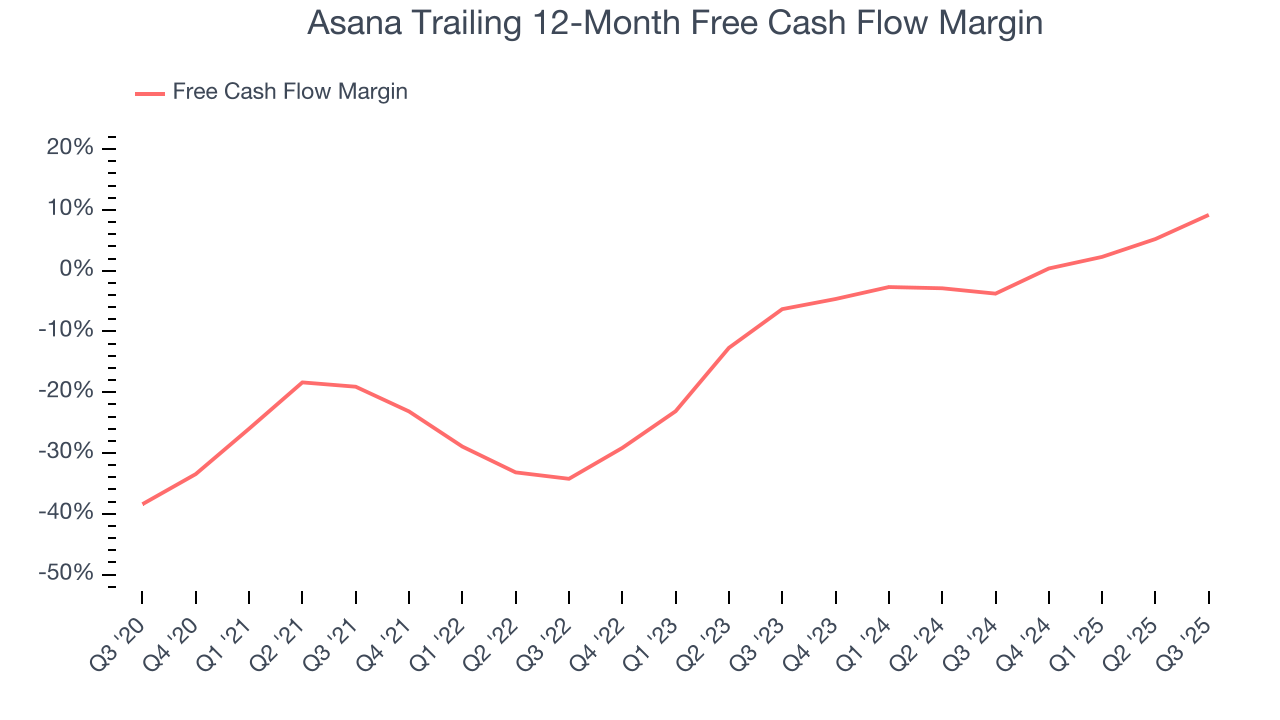
Asana’s free cash flow clocked in at $13.43 million in Q3, equivalent to a 6.7% margin. Its cash flow turned positive after being negative in the same quarter last year, but we wouldn’t put too much weight on the short term because investment needs can be seasonal, causing temporary swings. Long-term trends carry greater meaning.
Over the next year, analysts predict Asana’s cash conversion will improve. Their consensus estimates imply its free cash flow margin of 9.2% for the last 12 months will increase to 13.8%, it options for capital deployment (investments, share buybacks, etc.).
13. Balance Sheet Assessment
One of the best ways to mitigate bankruptcy risk is to hold more cash than debt.
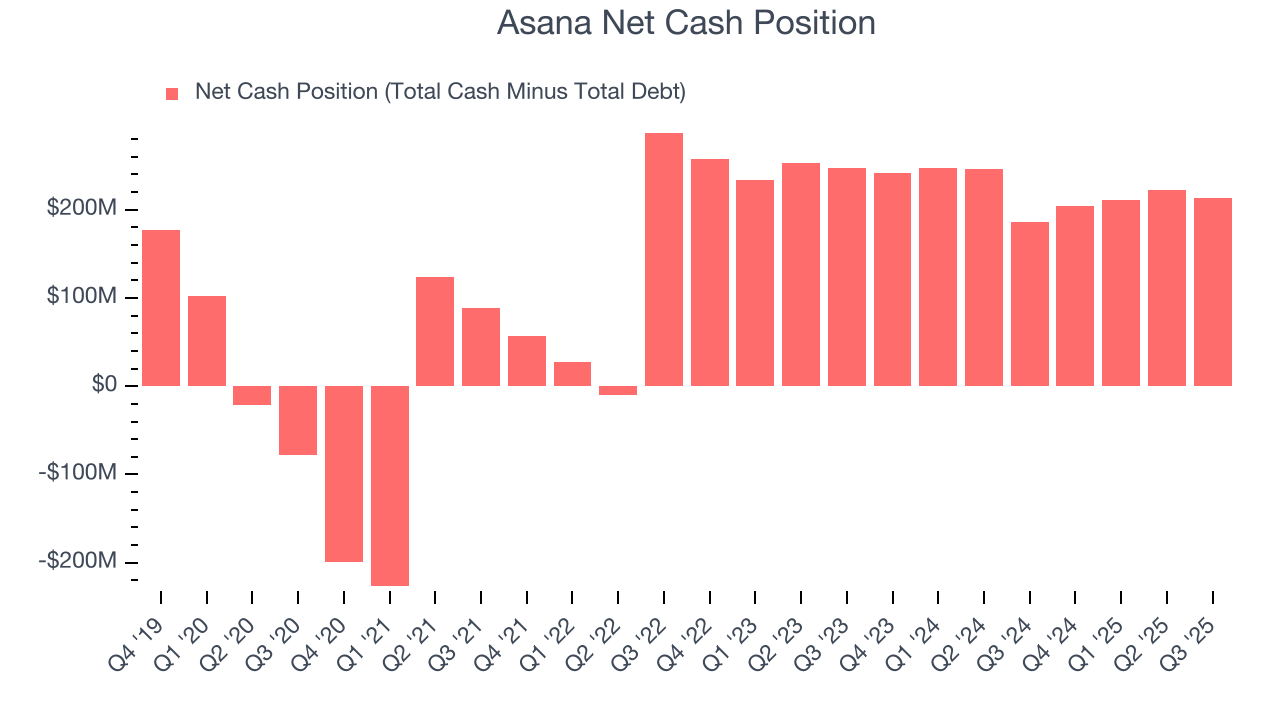
Asana is a well-capitalized company with $463.6 million of cash and $250 million of debt on its balance sheet. This $213.7 million net cash position is 6.4% of its market cap and gives it the freedom to borrow money, return capital to shareholders, or invest in growth initiatives. Leverage is not an issue here.
14. Key Takeaways from Asana’s Q3 Results
We were impressed by Asana’s optimistic EPS guidance for next quarter, which blew past analysts’ expectations. We were also glad its full-year EPS guidance trumped Wall Street’s estimates. Overall, we think this was a decent quarter with some key metrics above expectations. The stock traded up 5% to $14.11 immediately following the results.
15. Is Now The Time To Buy Asana?
Updated: December 4, 2025 at 9:03 PM EST
Are you wondering whether to buy Asana or pass? We urge investors to not only consider the latest earnings results but also longer-term business quality and valuation as well.
Asana doesn’t pass our quality test. Although its revenue growth was strong over the last five years, it’s expected to deteriorate over the next 12 months and its operating margins reveal poor profitability compared to other software companies. And while the company’s admirable gross margin indicates excellent unit economics, the downside is its software has low switching costs and high turnover.
Asana’s price-to-sales ratio based on the next 12 months is 4.1x. This multiple tells us a lot of good news is priced in - we think there are better opportunities elsewhere.
Wall Street analysts have a consensus one-year price target of $15.76 on the company (compared to the current share price of $14.12).

